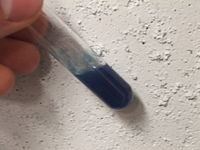Formula Co(OH)2 Density 3.6 g/cm³ | Molar mass 92.948 g/mol Melting point 168 °C | |
 | ||
Appearance rose-red powder or bluish-green powder | ||
Precipitation of cobalt ii hydroxide
Cobalt(II) hydroxide or cobaltous hydroxide is the chemical compound composed of cobalt and the hydroxide ion with the formula Co(OH)2. It occurs in two forms, either as a rose-red powder, which is the more stable of the two forms, or as bluish-green powder. It has the brucite or cadmium iodide crystal structure.
Contents
Uses
Cobalt(II) hydroxide is most commonly used as a drying agent for paints, varnishes and inks, in the preparation of other cobalt compounds, as a catalyst and in the manufacture of battery electrodes.
Reactions
Cobalt(II) hydroxide is precipitated when an alkaline hydroxide is added to an aqueous solution of Co2+ ions:
CoCl2 (aq) + 2 NaOH → Co(OH)2 (s) + 2 NaClCobalt(II) hydroxide decomposes to cobalt(II) oxide at 168 °C under vacuum and is oxidized by air to form cobalt(III) hydroxide, Co(OH)3. The thermal decomposition product in air above 300 °C is Co3O4.
Like iron(II) hydroxide, cobalt(II) hydroxide is primarily a basic hydroxide, although it does form the weakly acidic reddish hexaaquacobalt(II) ion, [Co(H2O)6]2+, in acidic aqueous solutions. In strong bases, cobalt(II) hydroxide accepts additional hydroxide ions to form dark blue cobaltates(II) [Co(OH)4]2− and [Co(OH)6]4−.
